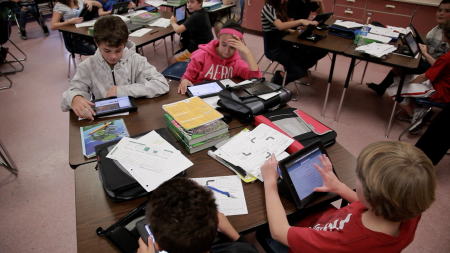For many public schools, incorporating mobile devices into the classroom is a daunting and potentially cost prohibitive endeavor. Conrad Ball Middle
School in Loveland, Colo. realized this technological leap through a grant from a local charitable family foundation. The grant allowed the school to launch a 1:1 Apple iPad program for its 670 students. To protect this investment in innovative education, the school turned to OtterBox.
For many students at Conrad Ball, an iPad was not a tool to which they had ready access. About 40 percent of the student population is eligible for the free/reduced-price lunch program.
“A lot of the students at this school would not have had the opportunity to use this type of technology,” said Conrad Ball instructional technologist
Michael Dubas. “Many of our students that now have this technology in their hands would have only seen it on TV, and it wouldn’t have related to their lifestyle. When you’re given an opportunity like this, all students have the same opportunity to achieve in this 21st century technology atmosphere.”
|
Snapshot: |
|---|
|
Prior to this program, Dubas taught social studies at the school where they had a set of classroom iPads that were used in lieu of traditional textbooks. When the school was selected for the grant to launch a 1:1 iPad program, he was tapped to provide instructional and technical support to students and teachers.
Dubas finds that when students are empowered to seek out and creatively digest information, they are more actively engaged in learning. Putting an iPad rather than a textbook into the hands of a student heightens the sense of excitement for assignments and sparks a passion for learning.
“I’ve seen kids that struggle with traditional content rise above that because they were given a choice, and they were able to create something really cool and different,” Dubas said. “For kids that are already achieving at a high level, they can look at how learning is applied in the real world today and create a piece of that.”
The iPads have become an immeasurably valuable tool for teachers and students in a short amount of time. Teachers were given basic training on how to use the iPads and the standard set of applications and programs that would come with them — Keynote, iMovie, Pages and Noteability. They were then tasked with incorporating the devices into the classroom to enhance lessons, research and projects. Conrad Ball’s teachers have risen to the challenge.
“We did a lesson where they had to create a cooking show to demonstrate the different aspects of chemistry when you make a recipe,” explained Melissa Ring, eighth grade physical sciences teacher. “They went home and filmed a recipe and talked about physical and chemical change like Julie Child would. Everybody was engaged and learning. It was a really cool way to present the information as opposed to just a paper or poster or project.”

Ring also uses the iPads to gain immediate insight into the effectiveness of the day’s lesson. Using the education-focused social media tool Edmodo, students take a daily quiz or check-in to let her know who might have struggled to pick up the concepts and what areas might require review the following day. “I just can’t imagine teaching without it now,” Ring said.Keeping the teachers and students connected with these technological tools
was a challenge that the school faced early in the planning for program deployment. Dubas knew that while powerful, the iPads were also delicate. There were concerns throughout administration and the teaching staff that the 1:1 program could quickly become unfeasible without proper device protection. Selecting a protective case was an important consideration.
“We had cases before that were flimsy, and we had some cracked iPads,” Dubas said of the classroom set of devices used before the 1:1 program. “Students were dropping them and you have to remember these are $500-plus devices. We’re a school and we don’t just have a lot of extra money. If you’re going to make an investment like this, you have to protect it. There’s no way to go without it.”
Conrad Ball Middle School decided on the OtterBox Defender Series. This case consists of a rigid plastic shell with a built-in screen protector that snaps around the tablet and is then covered by a sturdy silicone skin. An included shield protects the screen of the device from perils in backpacks and hallways while doubling as a media/typing stand.
“The name OtterBox is the one that goes along with protection,” Dubas said. “We’ve had zero cracked iPads and you wouldn’t believe how many I’ve seen dropped.”
RELATED MATERIALS:
Conrad Ball Middle School Case Study Video
PDF VERSION OF CASE STUDY